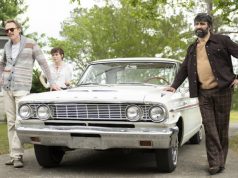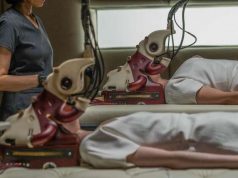“No End in Sight” is a calm, scathing documentary about the U.S. presence in Iraq, but it does not focus on whether the war was the “right” thing to do in the first place. Reasonable people can disagree on that point, and while the film does take the position that the invasion was a mistake to begin with, its real focus is on the aftermath. And that is where a clear, well nigh irrefutable point emerges: Right or wrong, when we did go into Iraq, we ought to have done a better job of it.
Sure, we were prepared to topple Saddam and liberate the country. We managed that in spectacular form. It was everything that followed that we completely screwed up on.
“No End in Sight” uses interviews with key participants and footage from Baghdad to lay out the facts of America’s occupation of Iraq, methodically and without sensationalism. Charles Ferguson, the producer and director, is a political scientist, not a filmmaker. He doesn’t use the cinematic tricks and techniques that a more accomplished showman like Michael Moore would use — and that’s good. It would detract from his message, which he presents unadorned, aided by the authoritative voice of narrator Campbell Scott.
The result is an excellent summary of the U.S. occupation. Ferguson doesn’t uncover new facts, really, but he does spell them out for audiences who may not have caught them while they were unfolding. It’s like taking a step back to see the big picture.
After the fall of Baghdad in 2003, the city was almost instantly plunged into a state of lawlessness and looting. U.S. soldiers stationed there did not intervene, and in fact were told not to. Their job, they were told, was not to be police officers. The problem with that position was twofold: One, what was their job, then? And two, someone needed to be police officers, because the city was fast falling apart.
It was falling apart literally, too, as the looting extended not just to pulling merchandise out of shops but to actually tearing buildings apart. Meanwhile, there’s Donald Rumsfeld at the White House press briefing, making fun of the news networks for repeatedly showing the same footage of a looter taking a vase from a store. His point was to suggest the looting was a minimal problem and that the news channels were exaggerating it. But the fact was, the news channels — still in their rah-rah, unquestioning phase in those early days of the war — were actually under-reporting the degree of lawlessness in the city. In reality, the city was becoming more and more dangerous.
The Office for Reconstruction and Humanitarian Assitance (ORHA) — established two months before the invasion and given very little in the way of resources or personnel — had made a list of important places in Baghdad that needed to be protected in the difficult time that would inevitably follow Saddam’s ouster. Ferguson reports that all but one of them were left unguarded by the U.S. military, including museums where priceless ancient artifacts of Iraqi culture were destroyed in the anarchy. The one that did get protection? An oil ministry.
There simply weren’t enough U.S. troops on hand to do the job properly. Everyone seemed to realize that later on. But in fact Rumsfeld and Paul Wolfowitz were warned well in advance by people with expertise in the area of post-war reconstruction that several hundred thousand troops would be necessary. Rumsfeld and Wolfowitz — both of whom had no relevant personal experience here — publicly insisted the idea was absurd. The job wouldn’t require any more than 100,000, they said, and that’s what they sent.
That’s emblematic of a theme that runs throughout the war and occupation: arrogance. Bush and his staff seemed to think that whatever they came up with would be good enough to get the job done. Their master plan gave precious little thought to what would happen AFTER Saddam was booted. They routinely either didn’t consult with experts — i.e., people with actual military and reconstruction experience — or consulted with them and then ignored their recommendations. Many key decisions were being made back in Washington by people who not only had little or no experience with military occupations, but who hadn’t even been to Baghdad to see what was going on. The ones who were in Baghdad, who were fervently giving suggestions to the bosses in Washington — well, those are the ones who were constantly disregarded.
“No End in Sight” suggests that our own inadequacy and mistakes led directly to the insurgency that now, four years later, still plagues us. When Baghdad fell into mayhem after Saddam was deposed, and when order was not quickly re-established, many ordinary Iraqis were left feeling desperate and frightened, and some turned to Islamic fundamentalism as a source of security.
Worse, though, was when the ORHA was replaced with the Coalition Provisional Authority (CPA), headed by one L. Paul Bremer. One of Bremer’s first acts was to disband the standing Iraqi army. This came as a surprise to nearly everyone, including Bremer’s own colleagues. (In keeping with the theme, he consulted almost no one before issuing the decree.) The consequence of his careless, rash decision? There were now 400,000 Iraqis who were a) unemployed, b) humiliated over not being able to provide for their families, and c) armed.
People like Rumsfeld and Wolfowitz declined to be interviewed for the film, naturally, but Ferguson has plenty of others on the record, speaking frankly about the series of mistakes the United States made in the early days of the occupation. Most of these are not anti-Bushites or people with axes to grind. They’re the people who were charged with implementing Bush’s policies, people who earnestly strived to do things right and simply didn’t have the resources to do it.
Among the figures interviewed are Jay Garner, who was head ORHA; a Marine lieutenant named Seth Moulton; Col. Paul Hughes, who was in charge of strategic policy and who would have tried to talk sense into Bremer about disbanding the Iraqi army if only he’d known he was planning it; and State Department figures Richard Armitage and Lawrence Wilkerson. It’s particularly eye-opening to see Armitage talk about being ignored every time he and Colin Powell — both experienced military commanders — gave recommendations to their inexperienced higher-ups.
It’s a sad, infuriating story, and it follows the classic themes of tragedy: hubris, and then a fall, all of it preventable. The film’s emphasis is the events of 2003, how those crucial early days were mishandled, and how the endeavor may have been doomed from the start by the lack of preparedness. Ferguson doesn’t indicate what he thinks should be done now, four years later, to rectify the situation, and for that reason some may take his film as nothing more than a liberal gloating over Bush’s failures. That would be a serious misreading, though. The film’s purpose is to analyze this specific period of time, not to make recommendations for the future. It comes across as something of a horror story: This happened, it was a fiasco, it didn’t have to be — and now there might not be any way of fixing it.
A- (1 hr., 49 min.; )





